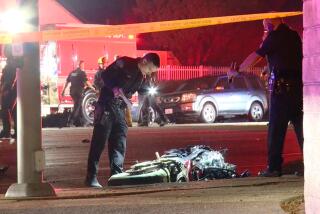For families of hit-and-run victims, haunting questions remain
- Share via
Debra Holt is relieved that the driver who struck and killed a 4-year-old girl in Glendale turned himself in. Matt Panagiotis is glad that the woman who fatally injured a judge’s son and kept driving was sentenced to prison.
Holt and Panagiotis — who themselves grieve loved ones mowed down by hit-and-run drivers — know how rarely those responsible are caught. They believe the drivers know that too.
“A lot of things have to fall into place,” said Panagiotis, whose best friend Michael Bonanomi, 35, was killed in 2013 as he crossed Ventura Boulevard.
That makes every solved case both a cause for celebration and a reminder of the suffering that most victims’ friends and families continue to endure.
“We applied as much pressure as we could,” Panagiotis said. Bonanomi’s friends spent weeks knocking on doors, posting signs and scouring side streets for evidence. Panagiotis bagged shards of glass and bits of auto parts he found on a street nearby, but detectives didn’t seem interested when he took the pieces to the police station, he said.
Uninterested or maybe overwhelmed.
Two other pedestrians were killed in hit-and-runs on the same night his friend died — one just a few miles from the spot in Studio City where the white Mercedes knocked Bonanomi onto its hood, then flung him to the ground as it zoomed off.
There are about 20,000 hit-and-run accidents in Los Angeles each year, most of them fender-benders. But 144 people were severely injured and 27 people killed last year by drivers who did not stop. Over the years, only about 1 in 10 hit-and-run drivers has been arrested or prosecuted.
“The LAPD doesn’t have the manpower,” Panagiotis said. “You just have to hope that people will turn themselves in.”
::
It’s been two months since Debra Holt’s oldest child was killed near Slauson and Denker avenues in South Los Angeles. Treva Arnold, 39 and a mother of two, was crossing the street in the middle of the night when she was struck by one, maybe two, speeding cars.
“I read the autopsy report,” Holt said. The accident severed her daughter’s spine. She bled to death in the street.
“Somebody must have seen something,” Holt told me Sunday night as she marked her birthday with a meal that wasn’t nearly as good as the birthday dinners her daughter always prepared.
“I’m about to make up some fliers, let them know there’s a $50,000 reward and go over in that area and post them,” she said.
The Los Angeles City Council makes a point of offering rewards to try to flush out hit-and-run drivers. Last month, city officials agreed to begin employing electronic alerts, like the kind used for abducted children, to enlist drivers’ help in finding hit-and-run suspects.
But none of that addresses the question at the heart of the problem:
“How could somebody be so cold-hearted as to just hit a person and keep driving on?” Holt asked more than once as we talked about her daughter.
“We all make mistakes; none of us is perfect,” she said. “But you know that’s a human being, just like you. And you don’t have the conscience to say: ‘I did this.’”
::
Why don’t drivers stop? Often the accident is not even their fault, but running makes it a crime.
Some panic. They’re scared, confused, don’t want to believe that they hit someone. Some may be drunk or under the influence of drugs — running buys time to clean up. Some say they were afraid they’d be attacked by a vengeful crowd.
But mostly they run because they can. It’s wrong, but in the moment, it may seem to a coward like a logical choice.
“If you put your morals aside, it’s probably the smart thing to do,” Panagiotis acknowledged. “That’s the unfortunate truth at the moment. We’ve got to change that.”
He’d like to see more thorough investigations, tougher penalties and consistent enforcement. He’d like to see homicide detectives handle every hit-and-run death, not just the high-profile ones.
That might mean fewer unsolved cases.
But it won’t do much to lessen the pain left by a loved one’s death.
Just ask Jeri Dye Lynch, whose 16-year-old son, Conor, was killed four years ago, a block from his high school in Sherman Oaks.
The young woman who hit him drove on, but eventually stopped and approached police officers, who brought her back to the scene. She was prosecuted for a misdemeanor instead of a felony.
She was crying at the scene and during her court hearing, Lynch recalled.
“And all I could think about was that somebody actually let a 16-year-old boy die in the street alone … when all she had to do was pull over and dial 911.”
Lynch tried to stifle her weeping. “I know she was scared. I would be scared too. But if you can’t be the person who’ll stop and render aid when you hurt someone, you shouldn’t be driving,” she said.
“That’s such a horrific statement of our society.…How do you not stop and help?”
Twitter: @SandyBanksLAT
More to Read
Sign up for Essential California
The most important California stories and recommendations in your inbox every morning.
You may occasionally receive promotional content from the Los Angeles Times.














